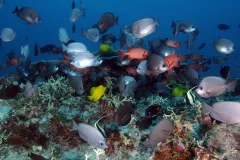World Heritage Goes Marine

Last week, the United Nations’ World Heritage Convention went blue. Two of the largest and healthiest marine protected areas on our planet—the Phoenix Islands Protected Area in Kiribati and Papahānaumokuākea Marine National Monument in Hawaii—have now gained World Heritage status. Together, they more than doubled the marine area protected under the World Heritage Convention—now 1.6 million square kilometers (more than 617,000 square miles) or about 0.5 percent of the world’s ocean surface.
The Phoenix Islands Protected Area conserves one of the world’s largest intact coral archipelago ecosystems, 14 known seamounts, and other deep-sea habitats. The area is teeming with wildlife, including roughly 200 coral species, 500 fish species, 18 marine mammals, and 44 bird species. It serves as a migration route and reservoir of marine life and reminds us how these stunning ecosystems look and function in a pristine state.
Papahānaumokuākea is equally exceptional. Roughly 250 kilometers (155 miles) northwest of the main Hawaiian archipelago, this isolated chain of low-lying islands and atolls is made up of open ocean and deepwater habitats, with notable features such as seamounts and submerged banks, extensive coral reefs and lagoons. The area has deep cosmological and traditional significance for Native Hawaiian culture, as an ancestral environment, and as an embodiment of the Hawaiian concept of kinship between people and the natural world. The site is also home to the endangered Hawaiian monk seal, the graceful spinner dolphin, and hundreds of other species.
Both sites join an already prestigious list of 43 marine ecosystems and biodiversity treasures that make up Marine World Heritage. Places like the Galapagos Islands—a melting pot of unusual marine life—and the Wadden Sea, which annually serves as a staging post for more than 10 million birds, providing them with enough food to complete their long journeys to the south. Among the most abundant are the Black-headed Gull, Lesser Black-backed Gull, and Herring Gull.
Recognition of marine World Heritage only began in 1981 with the inscription of Australia’s Great Barrier Reef Marine Park to the World Heritage List. The two new sites mark an important milestone in the World Heritage Marine Programme’s mission to protect the highest quality and most iconic natural and cultural sites for future generations. Although the ocean covers more than 70 percent of Earth’s surface, terrestrial and cultural heritage long remained the focus of the Convention, leaving the opportunities for the ocean largely untouched. But this year’s World Heritage Committee meeting—held in Brazil from July 25 to August 2—clearly marked the start of a new era.
Inscription on the World Heritage List is only the beginning, however. Much work remains to be done to safeguard the “Crown Jewels of our Ocean.” Identifying other sites from under-represented geographic regions and ecosystems and, most importantly, improving the management of marine World Heritage sites already listed are key priorities. Sadly, multiple stressors threaten their conservation and challenge the core values we all treasure so much. While some sites are very well managed, others lack the capacity and are on the brink of serious degradation. We must strengthen the community of Marine World Heritage site managers because, together, they can truly make a world of difference!
Editor’s Note: Fanny Douvere is the Coordinator of UNESCO’s World Heritage Marine Programme—our newest Ocean Portal Collaborator.
View an Ocean Portal slideshow of all Marine World Heritage sites.
Explore Marine World Heritage sites through maps, links, video, and more.

